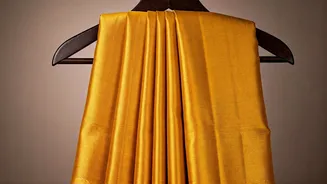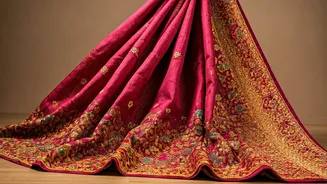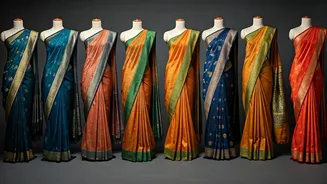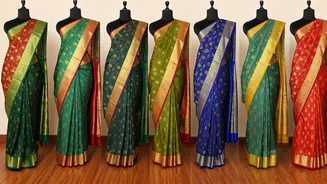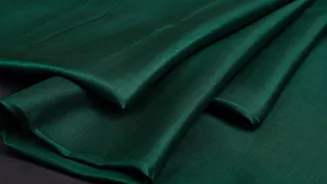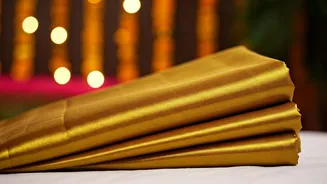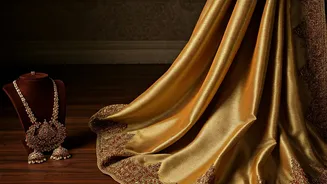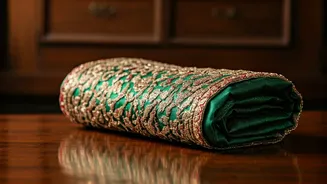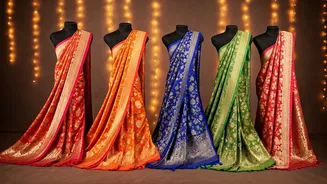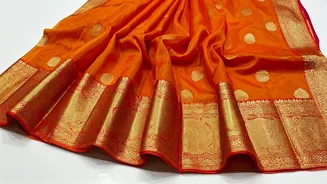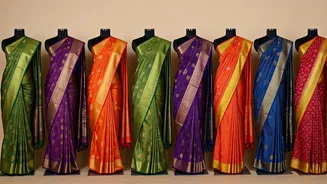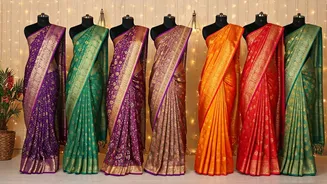Timeless Silk Elegance
Plain silk sarees have consistently remained a favorite choice for women, particularly in South Indian wedding celebrations. These sarees, known for their
rich texture and simple elegance, offer a sophisticated look that complements the grandeur of weddings. Actresses such as Rashmika Mandanna and Shriya Saran frequently incorporate these sarees into their wedding wardrobes. This preference underscores the versatility of plain silk sarees, as they can be styled to create a range of looks, from classic to contemporary. The charm of these sarees lies in their ability to be paired with various blouse designs, jewelry, and accessories, allowing for individual expression. Their simplicity is their strength, providing a canvas for personal style while still retaining a formal feel. The timeless quality of plain silk sarees ensures they remain relevant and stylish across generations, making them a staple in any wedding season.
Actresses' Styling Secrets
The ways in which South Indian actresses style their plain silk sarees offer valuable inspiration. These actresses often pair their sarees with contrasting or complementary blouse designs, such as intricately embroidered blouses or blouses with modern necklines. Jewelry choices play a significant role as well; traditional gold jewelry often complements the rich colors of the silk, while more contemporary pieces can add a modern touch. The choice of hairstyle and makeup also contributes to the overall look, with options ranging from classic updos to more relaxed styles. A well-chosen saree will make a bold statement, but can also be styled to become a part of the person's identity. From the selection of color combinations, they often incorporate traditional elements, such as temple jewelry or gajras, or opt for more minimalist accessories that let the saree take center stage. These actresses highlight the adaptability of plain silk sarees, offering a wide array of styling possibilities for weddings and festive occasions.
Sarees for Wedding Seasons
Plain silk sarees are ideally suited for the wedding season due to their ability to provide a look of sophistication. The fabric’s texture and sheen create a luxurious feel, making them perfect for celebratory events. When choosing a plain silk saree for a wedding, factors such as the color, weight of the fabric, and design of the blouse are important. Bold colors like deep reds, emerald greens, and royal blues are frequently preferred for weddings. These colors convey a sense of richness and complement the celebratory atmosphere. The weight of the silk will also influence how the saree drapes and feels. Lighter silks are suitable for warmer climates or daytime events, while heavier silks can provide structure and warmth for evening celebrations. The blouses can vary based on individual tastes. It could be intricately embroidered designs, or modern, minimalist styles. The blend of the saree’s elegance with the right accessories creates a stunning ensemble. For any Indian wedding, the sarees provide a timeless look.
Contemporary Fashion Integration
Plain silk sarees aren't just for traditional events; they can be incorporated into modern fashion. Modern styling involves experimenting with different blouse styles, mixing and matching traditional sarees with contemporary accessories, and layering the saree in unique ways. Designers and fashion enthusiasts are constantly evolving how these sarees are presented. They have embraced unconventional draping styles, such as pleating the saree in innovative ways or wearing it with a belt to define the waist. Modern blouses, with off-the-shoulder designs, halter necks, or even crop tops, are often paired with these sarees to create a fusion look. Contemporary accessories, like statement belts, modern jewelry, and stylish footwear, also help to modernize the overall look. By adding personal touches and experimenting with different elements, the plain silk saree can seamlessly integrate into modern fashion. Plain silk sarees' versatility makes them an ideal choice for fashion-forward people.
